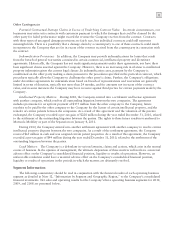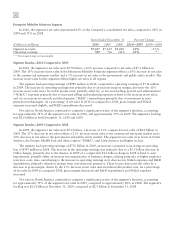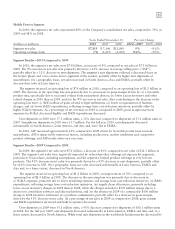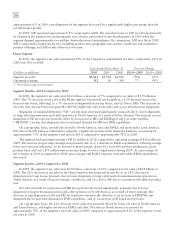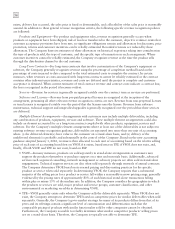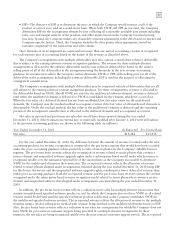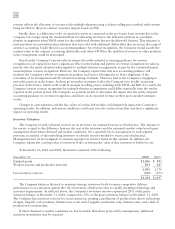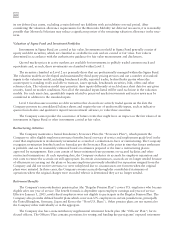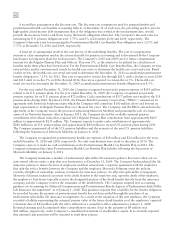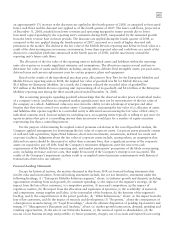Motorola 2010 Annual Report Download - page 64
Download and view the complete annual report
Please find page 64 of the 2010 Motorola annual report below. You can navigate through the pages in the report by either clicking on the pages listed below, or by using the keyword search tool below to find specific information within the annual report.
56
exists, delivery has occurred, the sales price is fixed or determinable, and collectibility of the sales price is reasonably
assured. In addition to these general revenue recognition criteria, the following specific revenue recognition policies
are followed:
Products and Equipment—For product and equipment sales, revenue recognition generally occurs when
products or equipment have been shipped, risk of loss has transferred to the customer, objective evidence exists that
customer acceptance provisions have been met, no significant obligations remain and allowances for discounts, price
protection, returns and customer incentives can be reliably estimated. Recorded revenues are reduced by these
allowances. The Company bases its estimates of these allowances on historical experience taking into consideration
the type of products sold, the type of customer, and the specific type of transaction in each arrangement. Where
customer incentives cannot be reliably estimated, the Company recognizes revenue at the time the product sells
through the distribution channel to the end customer.
Long-Term Contracts—For long-term contracts that involve customization of the Company’s equipment or
software, the Company generally recognizes revenue using the percentage of completion method based on the
percentage of costs incurred to date compared to the total estimated costs to complete the contract. In certain
instances, when revenues or costs associated with long-term contracts cannot be reliably estimated or the contract
contains other inherent uncertainties, revenues and costs are deferred until the project is complete and customer
acceptance is obtained. When current estimates of total contract revenue and contract costs indicate a contract loss,
the loss is recognized in the period it becomes evident.
Services—Revenue for services is generally recognized ratably over the contract term as services are performed.
Software and Licenses—Revenue from pre-paid perpetual licenses is recognized at the inception of the
arrangement, presuming all other relevant revenue recognition criteria are met. Revenue from non-perpetual licenses
or term licenses is recognized ratably over the period that the licensee uses the license. Revenue from software
maintenance, technical support and unspecified upgrades is generally recognized over the period that these services
are delivered.
Multiple-Element Arrangements—Arrangements with customers may include multiple deliverables, including
any combination of products, equipment, services and software. These multiple element arrangements could also
include an element accounted for as a long-term contract coupled with other products, equipment, services and
software. For the Company’s multiple-element arrangements where at least one of the deliverables is not subject to
existing software revenue recognition guidance, deliverables are separated into more than one unit of accounting
when: (i) the delivered element(s) have value to the customer on a stand-alone basis, and (ii) delivery of the
undelivered element(s) is probable and substantially in the control of the Company. Based on the new accounting
guidance adopted January 1, 2010, revenue is then allocated to each unit of accounting based on the relative selling
price of each unit of accounting based first on VSOE if it exists, based next on TPE if VSOE does not exist, and,
finally, if both VSOE and TPE do not exist, based on ESP.
• VSOE—In many instances, products are sold separately in stand-alone arrangements as customers may
support the products themselves or purchase support on a time and materials basis. Additionally, advanced
services such as general consulting, network management or advisory projects are often sold in stand-alone
engagements. Technical support services are also often sold separately through renewals of annual contracts.
The Company determines VSOE based on its normal pricing and discounting practices for the specific
product or service when sold separately. In determining VSOE, the Company requires that a substantial
majority of the selling prices for a product or service fall within a reasonably narrow pricing range, generally
evidenced by the pricing rates of approximately 80% of such historical stand-alone transactions falling
within plus or minus 15% of the median rate. In addition, the Company considers the geographies in which
the products or services are sold, major product and service groups, customer classification, and other
environmental or marketing variables in determining VSOE.
• TPE—VSOE generally exists only when the Company sells the deliverable separately. When VSOE does not
exist, the Company attempts to determine TPE based on competitor prices for similar deliverables when sold
separately. Generally, the Company’s go-to-market strategy for many of its products differs from that of its
peers and its offerings contain a significant level of customization and differentiation such that the
comparable pricing of products with similar functionality sold by other companies cannot be obtained.
Furthermore, the Company is unable to reliably determine what similar competitor products’ selling prices
are on a stand-alone basis. Therefore, the Company is typically not able to determine TPE.







